It is difficult to do without well-oiled and reliably working ventilation both at work and at home. It allows you to regularly renew the air in the premises of factory workshops and in apartment buildings, significantly increasing the comfort of staying in them. There are two known ways to organize effective air exchange: natural and forced ventilation. The second of these options is of particular interest.
What is forced ventilation
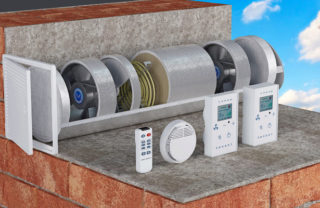
Ventilation is generally understood as a deliberately created system of air renewal, implemented by replacing the waste masses with new, supply ones. In contrast to the natural process caused by the difference in temperature (pressure) inside and outside the building, a forced ventilation system needs a special motive force. An electric fan is usually used as the latter.
An additional element leads to the fact that the work on the arrangement of forced ventilation in the apartment also becomes more complicated. In this case, a careful calculation of all elements of the system is required, tied to the characteristics of the serviced object. When preparing for the independent design of the ventilation complex, the following points are taken into account:
- selection of air ducts convenient for placement within a house or apartment;
- drawing up a wiring diagram of their wiring;
- purchase of a fan of the required power.
Only after solving all these issues, you can proceed directly to the installation work.
Features and device
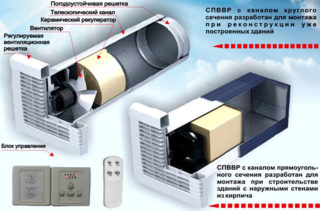
The device of the forced exchange system is rather complicated, since, in addition to air ducts and a fan, it includes the following mandatory elements:
- air intake grilles that are attached from the outside and protect the air ducts from mice, insects and small debris;
- cleaning filter system;
- air valves;
- heaters and sound absorbers;
- automation that controls the operation of all elements of the system.
Filters clean the incoming air masses from impurities (dust, lint and microparticles), and air valves are needed to regulate the force of the flow coming from the outside. In cold weather, they insulate the system from strong gusts of wind. Sound absorbers ensure quiet operation of forced exhaust ventilation, and air heaters regulate the supply air temperature in winter.
Advantages and disadvantages
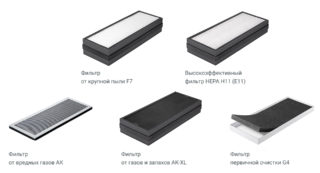
The advantages of forced ventilation include:
- independence from weather conditions and a guaranteed inflow of fresh and exhaust air;
- the ability to change operating modes by fine-tuning them;
- provision of the system with air purified from impurities, dust and microorganisms;
- admissibility of heating incoming air masses in winter.
It is also important to note the possibility of using the recuperation effect in forced systems, which makes it possible to reduce the cost of heating and space heating. The listed advantages do not exclude the presence of disadvantages of this ventilation method. Forced extraction has the following disadvantages:
- high costs for arranging the system;
- the complexity of design, installation and subsequent maintenance;
- the need for regular technical inspection of the system and routine maintenance (including replacement of worn out elements);
- increased noise in rooms during ventilation operation.
In addition, dependence on electricity supply is considered a disadvantage of these systems.
The main types of forced ventilation
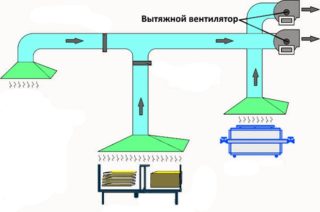
According to the method of organizing air circulation, forced ventilation is conventionally divided into the following three types:
- supply;
- exhaust;
- supply and exhaust.
In the first case, the fan is installed in the air intake duct (such a scheme is used in the bathroom, for example), and in the second, in the chimney. The third option is considered as a combination of the first two, when the ventilation device is installed in both ducts at once. Each of the varieties is capable of solving a certain range of problems related to the peculiarities of the operation of various premises.
Forced ventilation is most often installed in a bathroom, combined with a toilet, or in the kitchen. To do this, a powerful fan is installed in the ventilation shaft that goes to the toilet, and a typical hood is made in the kitchen room, which ensures the removal of exhaust air.
Regardless of the selected ventilation duct layout, it is recommended to consult with specialists before starting work.
Features of installation of forced ventilation
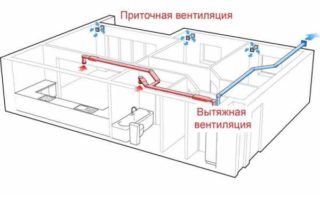
Self-assembly of ventilation is associated with many mistakes that it is desirable to exclude in advance. Even at the stage of project preparation, you should decide which rooms will be involved, and mark the routes for laying the air ducts. When doing independent work, it is important to take into account the following installation features:
- The bolts on the brackets are tightened to the stop.
- The use of rubber pads (vibration isolation elements) on the fasteners is mandatory. They are selected taking into account the weight of the boxes and guarantee a reduction in the level of vibrations (the latter are not transmitted to the operating units).
- The fans are mounted on a previously prepared base at the final stage of work. To fix them, rigid supports are used, on which they are attached with anchor bolts.
- The filter elements are mounted without sagging.
- The motors are installed as close to the fans as possible (close to them).
Regulatory requirements prescribe the use of special grilles that cover the inlet and outlet windows of the openings. The dimensions of the cells should not exceed 7 cm. It is also important to ensure that the number of turns and bends in the duct is minimal. Otherwise, you will need to increase the fan power.
Installation care rules
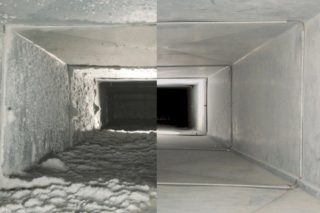
Self-made ventilation will serve the owners for many years, if its prevention is carried out in a timely manner. Maintenance of ventilation equipment depends on its composition and location. In expensive kitchen hoods, for example, you will need to periodically change filters, and maintenance of budget models comes down to rinsing them under warm water.
To avoid damage to the fans, they should be cleaned of dust deposits and small particles of debris at least once a month. Bolted connections are periodically checked for strength and tightened if necessary. Competent and timely maintenance of ventilation equipment is a reliable guarantee of its long service life.








